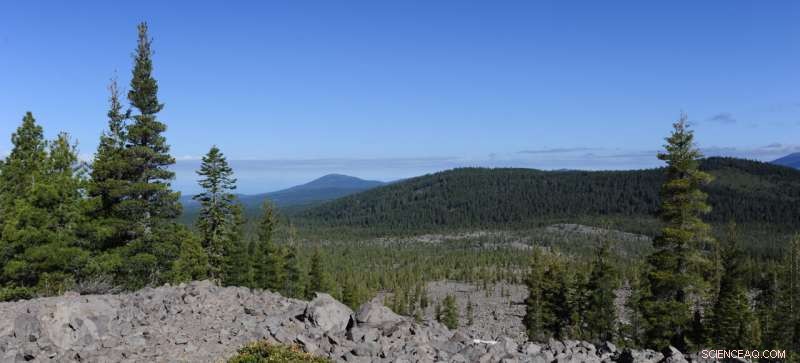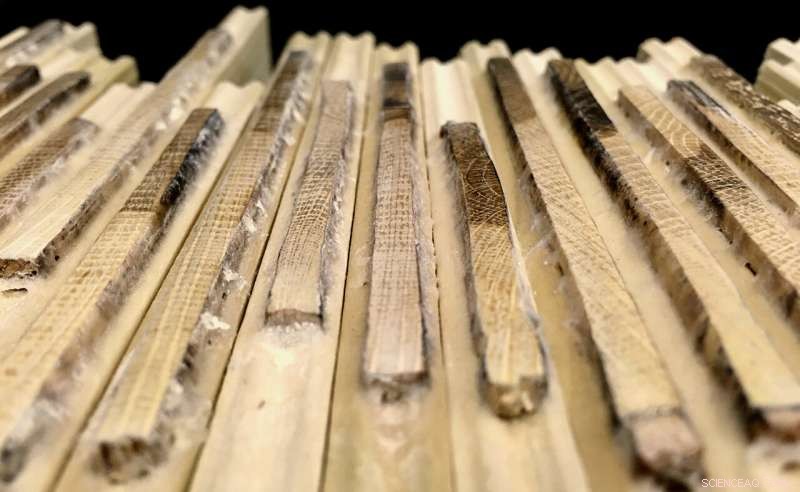
En barrskog i norra Kalifornien. Kredit:Antoine Cabon
Vad kommer att hända med världens skogar i en värmande värld? Kommer ökad atmosfärisk koldioxid att hjälpa träd att växa? Eller kommer extrema temperaturer och nederbörd att hålla tillbaka tillväxten? Allt beror på om trädtillväxten är mer begränsad av mängden fotosyntes eller av miljöförhållandena som påverkar trädcelltillväxt - en grundläggande fråga inom trädbiologin, och en som svaret inte var väl förstått förrän nu.
En studie ledd av forskare vid University of Utah, med ett internationellt team av samarbetspartners, finner att trädtillväxt inte verkar begränsas generellt av fotosyntes utan snarare av celltillväxt. Detta tyder på att vi måste tänka om hur vi förutspår skogstillväxt i ett föränderligt klimat, och att skogar i framtiden kanske inte kommer att kunna absorbera så mycket kol från atmosfären som vi trodde.
"Ett träd som växer är som ett häst- och vagnsystem som rör sig framåt på vägen", säger William Anderegg, docent vid U:s School of Biological Sciences och huvudutredare av studien. "Men vi vet i princip inte om fotosyntesen är hästen oftast eller om det är cellexpansion och -delning. Det här har varit en långvarig och svår fråga på området. Och det är oerhört viktigt för att förstå hur träd kommer att reagera på klimatförändringar."
Studien publiceras i Science .
Källa kontra sjunka
Vi lärde oss grunderna i grundskolan – träd producerar sin egen mat genom fotosyntes, tar solljus, koldioxid och vatten och förvandlar det till löv och trä.
Det finns mer i historien, dock. För att omvandla kol från fotosyntesen till trä krävs att träceller expanderar och delar sig.
Så träd får kol från atmosfären genom fotosyntes. Detta är trädens kol källa . De spenderar sedan det kolet för att bygga nya träceller – trädets kol sjunker .

Träkärnor förberedda för mätning av ringbredd. Kredit:Antoine Cabon
Om trädens tillväxt är källbegränsad, så begränsas den bara av hur mycket fotosyntes trädet kan utföra och trädtillväxt skulle vara relativt lätt att förutsäga i en matematisk modell. Så stigande koldioxid i atmosfären borde lätta på den begränsningen och låta träd växa mer, eller hur?
Men om istället trädens tillväxt är sjunkbegränsad, så kan trädet bara växa så snabbt som dess celler kan dela sig. Många faktorer kan direkt påverka både fotosyntes och celltillväxthastighet, inklusive temperatur och tillgången på vatten eller näringsämnen. Så om träd är sjunkbegränsade, måste simulering av deras tillväxt inkludera sjunkresponsen på dessa faktorer.
The researchers tested that question by comparing the trees' source and sink rates at sites in North America, Europe, Japan and Australia. Measuring carbon sink rates was relatively easy—the researchers just collected samples from trees that contained records of growth. "Extracting wood cores from tree stems and measuring the width of each ring on these cores essentially lets us reconstruct past tree growth," says Antoine Cabon, a postdoctoral scholar in the School of Biological Sciences and lead author of the study.
Measuring carbon sources is tougher, but doable. Source data was measured with 78 eddy covariance towers, 30 feet tall or more, that measure carbon dioxide concentrations and wind speeds in three dimensions at the top of forest canopies, Cabon says. "Based on these measurements and some other calculations," he says, "we can estimate the total forest photosynthesis of a forest stand."
Decoupled
The researchers analyzed the data they collected, looking for evidence that tree growth and photosynthesis were processes that are linked, or coupled. They didn't find it. When photosynthesis increased or decreased, there was not a parallel increase or decrease in tree growth.
"Strong coupling between photosynthesis and tree growth would be expected in the case where tree growth is source limited," Cabon says. "The fact that we mostly observe a decoupling is our principal argument to conclude that tree growth is not source-limited."
Surprisingly, the decoupling was seen in environments across the globe. Cabon says they did expect to see some decoupling in some places, but "we did not expect to see such a widespread pattern."

Detail of a wood core with visible growth rings (more recent rings towards the left) and bark on the right. Credit:Antoine Cabon
The strength of coupling or decoupling between two processes can lie on a spectrum, so the researchers were interested in what conditions led to stronger or weaker decoupling. Fruit-bearing and flowering trees, for example, exhibited different source-sink relationships than conifers. More diversity in a forest increased coupling. Dense, covered leaf canopies decreased it.
Finally, coupling between photosynthesis and growth increased in warm and wet conditions, with the opposite also true:that in cold and dry conditions, trees are more limited by cell growth.
Cabon says that this last finding suggests that the source vs. sink issue depends on the tree's environment and climate. "This means that climate change may reshape the distribution of source and sink limitations of the world forests," he says.
A new way to look forward
The key takeaway is that vegetation models, which use mathematical equations and plant characteristics to estimate future forest growth, may need to be updated. "Virtually all these models assume that tree growth is source limited," Cabon says.
For example, he says, current vegetation models predict that forests will thrive with higher atmospheric carbon dioxide. "The fact that tree growth is often sink limited means that for many forests this may not actually happen."
That has additional implications:forests currently absorb and store about a quarter of our current carbon dioxide emissions. If forest growth slows down, so do forests' ability to take in carbon, and their ability to slow climate change.